If you’re an ecommerce marketer, Amazon should be seen as a big deal and a key part of your growth strategy in 2021.
Did you know that 63% of retail consumers start their product search on Amazon? This channel allows many businesses to get their foot in the door and attract attention and deliver solid ROI.
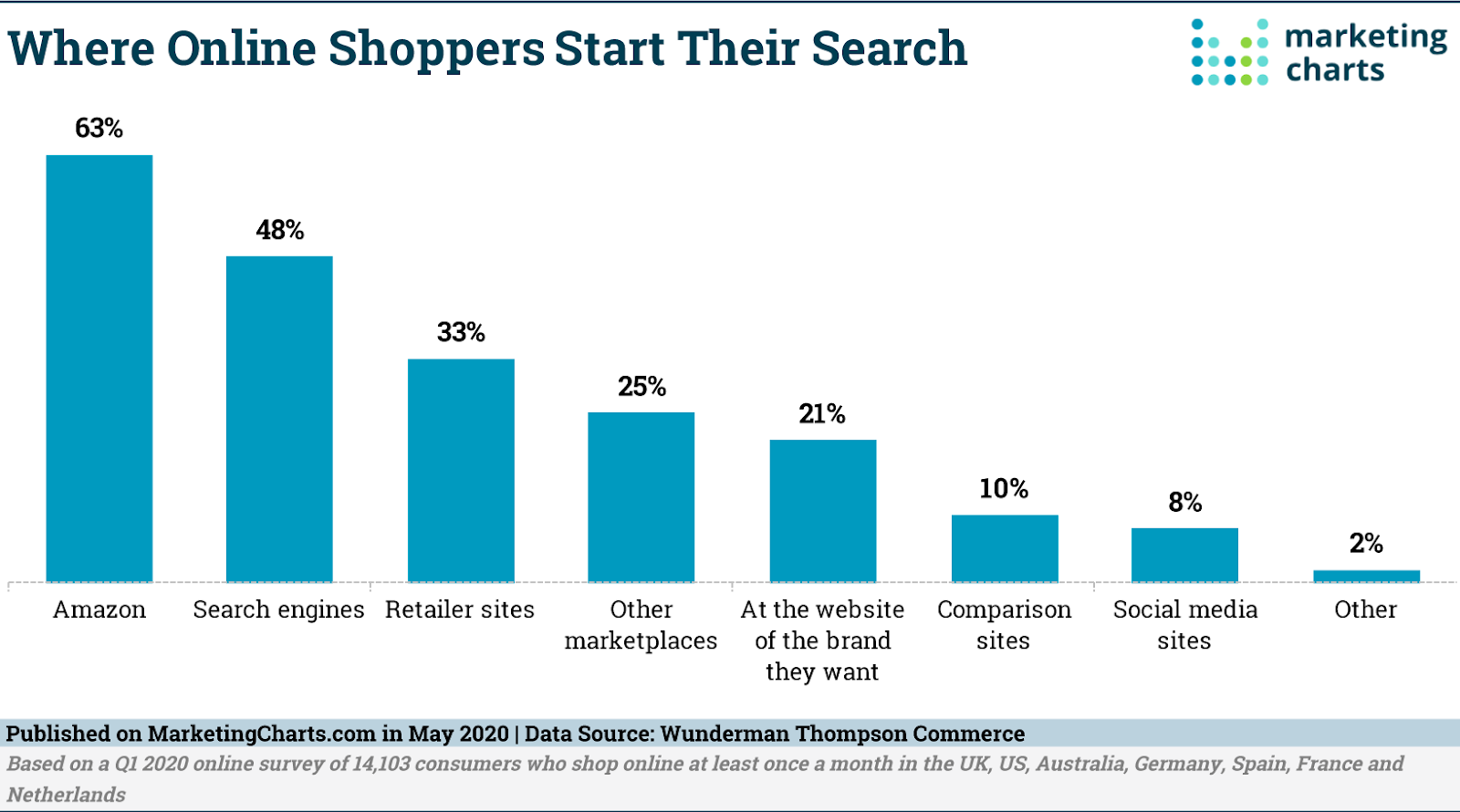
Image Credit: MarketingCharts.com
If you’re selling online and you’re not paying attention to the channel, there’s a good chance that your competitors are. That means you’re missing out on the chance to drive growth.
In many ways, Amazon SEO uses the same optimization principles as Google or other search engines, but there are several distinct differences. It’s not uncommon to hear marketers refer to Amazon’s A9 algorithm is similar to how Google's was back in the early 2010s, mostly due to the importance of keywords (Amazon uses other ranking factors, too).
Google has evolved beyond keywords to topics, but there’s still a huge emphasis on Amazon keywords. So, there's a distinct need to get your keyword research right.
In this guide, we’re going to talk you through the different ways to do Amazon keyword research and understand how to use keywords on the platform. Specifically, we’ll be looking at:
An Introduction to Amazon's A9 Algorithm Amazon Keywords Explained Using Keywords in Amazon Product Titles Using Keywords on Amazon Product Pages (About This Item and Descriptions) Amazon Hidden Keywords and Search Terms in Seller Central How To Do Amazon Keyword Research Building Your Seed List of Keywords Use Amazon's Search Bar for Keyword Suggestions Analyze Top-Ranked Pages on Google Use the Semrush Keyword Magic ToolAn Introduction to Amazon's A9 Algorithm
Before we dive deep into how to do Amazon keyword research, we'll help you better understand the algorithm that you’re optimizing for.
On Amazon, that’s the A9 algorithm, and this is what ranks products on the retailer results pages. Here's an example of a listing for phone cases:
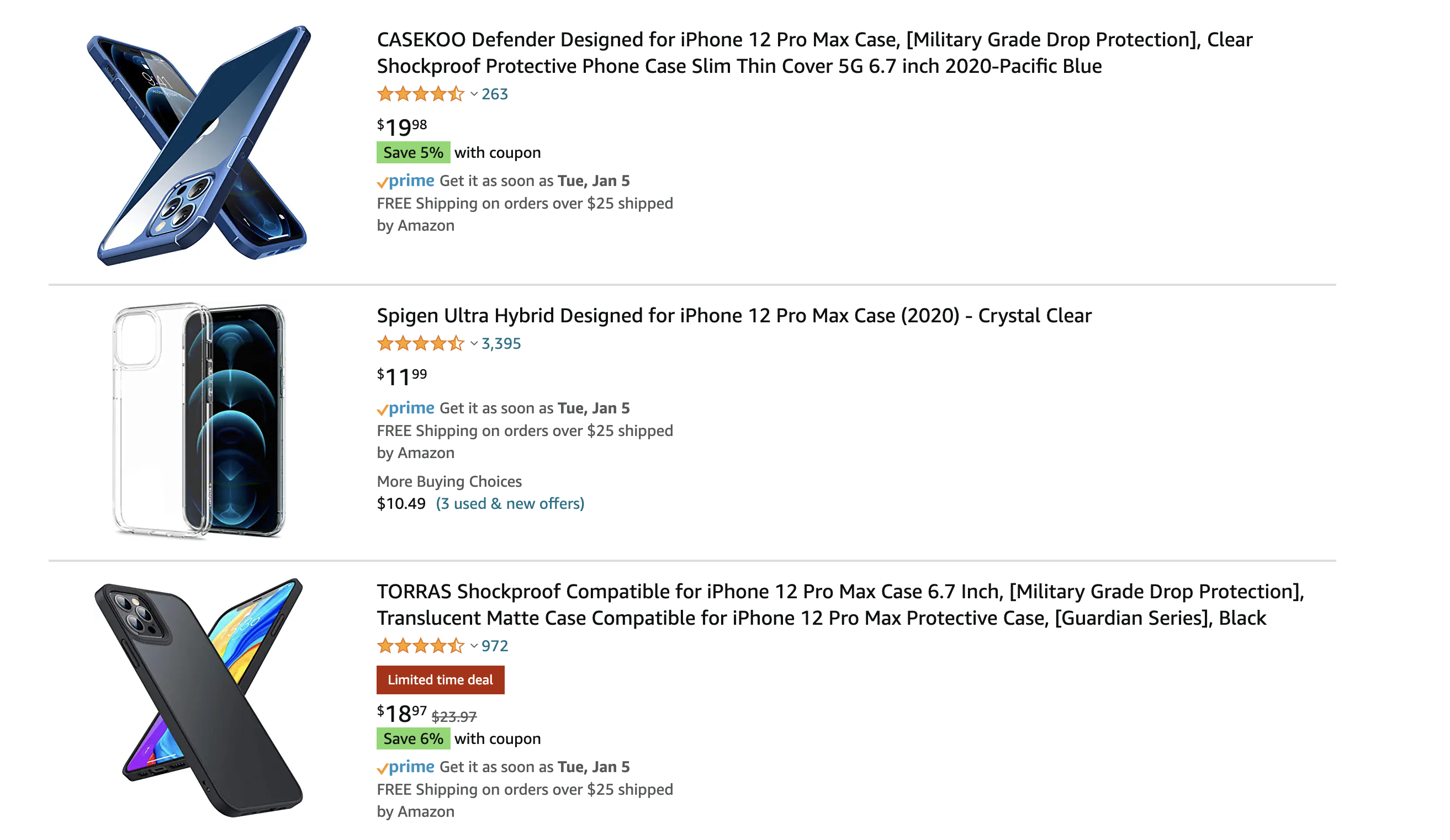
The algorithm uses keywords to determine which products offer the best results for any given search query. Unlike Google, Amazon also takes into account conversions when ranking products. This means that better-selling products (both in terms of volume and conversion rate) will typically outrank products with fewer sales or low conversion rates. Product reviews also feature prominently as a ranking factor.
While this does mean that products that have already landed lots of sales end up getting a lot more, you need to make sure you’re considering the way you optimize for conversions as well as clicks when putting together your listings.
Want to learn more about Amazon’s A9 algorithm? Check out our guide to Amazon SEO Strategy and Search Term Optimization.
Amazon Keywords Explained
Keywords are key to ranking your products. Before we take a look at several proven tactics for Amazon keyword research, let’s look at where you’ll be placing keywords on your product listings and the type of keywords you’ll need to find.
We can break Amazon keywords down into three areas of implementation:
Product titles
Product pages
Seller central hidden keywords
Knowing how to use keywords on Amazon can help focus your research and ensure you’re using them to drive targeted traffic that’s going to convert into sales, further increasing your products' visibility.
It's widely regarded that the priority order of importance for keyword usage on Amazon is:
Product Title> 'About this Item' Bullet Points> Hidden Keywords / Search Terms> Product Description
Using Keywords in Amazon Product Titles
Take a look at the title of pretty much any product that's ranking on Amazon, and the one thing that stands out is that they're almost always keyword stuffed.
While we all know that this doesn't work for Google, you need to understand that optimizing product titles on Amazon involves getting as many keyword variants into your title as possible, given that this is the most important area to have them included.

You'll want to place your main keywords at the start of your product title while including all of the main variants that people are searching for.
In the example above, we can clearly see the product primarily targets 'wireless charger' but then includes variants for the different phone and device models.
Using Keywords on Amazon Product Pages (About This Item and Descriptions)
Your product listing pages are your opportunity to include variations of your main keywords and write compelling descriptions that help you drive conversions.
While it's common for shoppers to skim product titles (especially when they're often making click decisions based on the image or price), you'll want to focus more on conversion-led descriptions here.
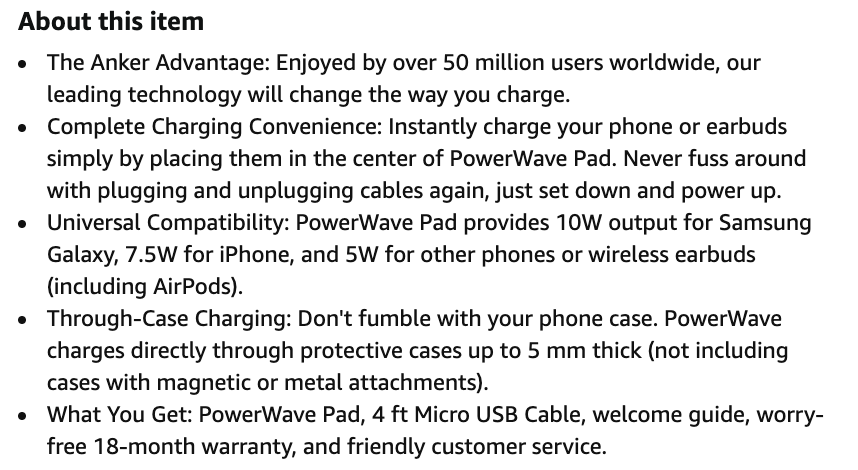
Given that sales and conversions are a key ranking factor for the A9 algorithm, it's important not to lose sight of the end goal: to encourage an 'add to cart.'
That said, you should be using your product keywords in both the 'about this item' section and the product description as this content is indexed and uses them when ranking products on search results and category pages.
Amazon Hidden Keywords and Search Terms in Seller Central
In your Amazon Seller Central account, you're able to fill out search terms for each product. These are sometimes referred to as 'hidden keywords' or 'Amazon backend keywords.'
According to Seller Lift, they "provide Amazon with additional information about a listing, and are used by the platform as another factor as to which search result said listing will rank….or not."
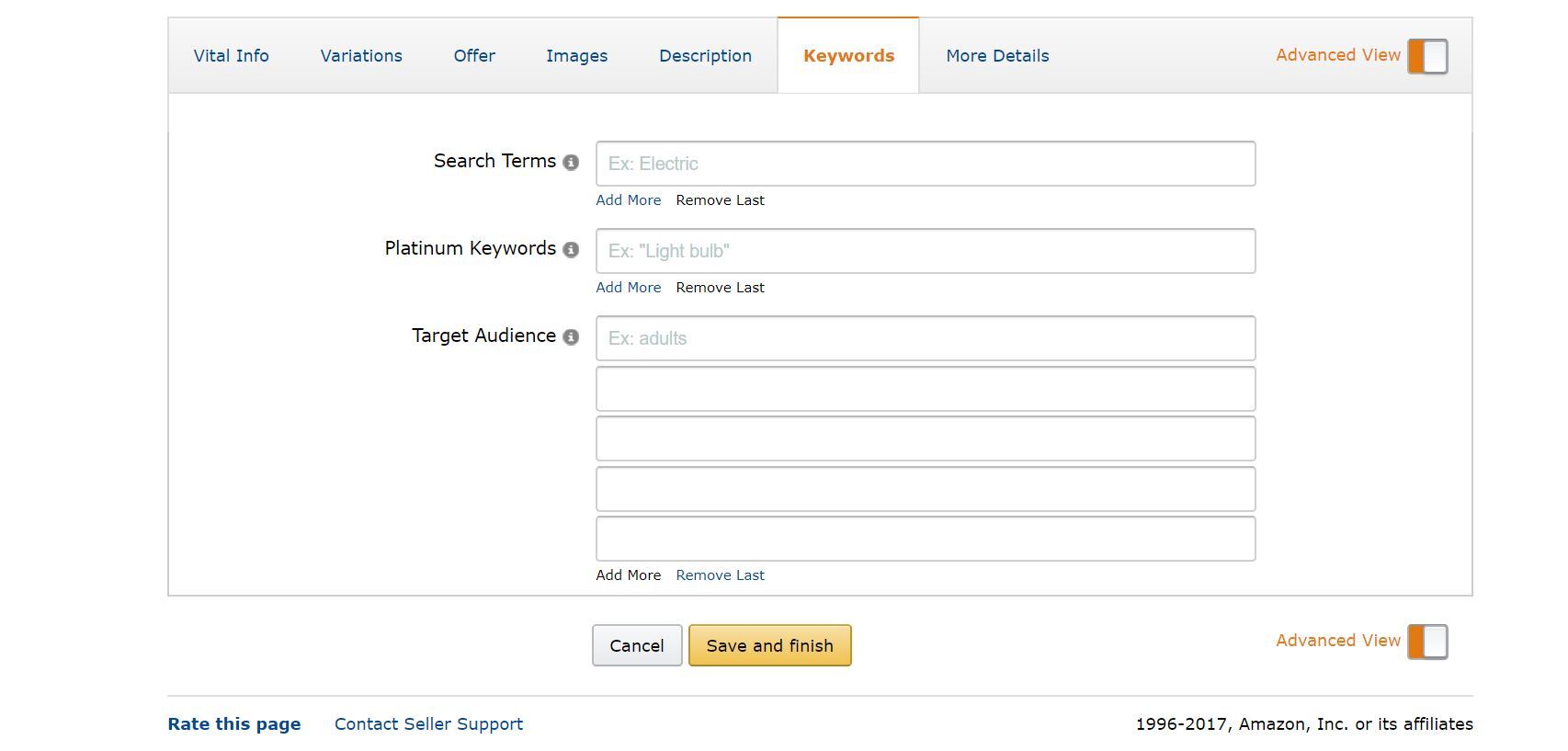
Image Credit: Seller Lift
They're not visible to consumers, hence why they're often called hidden keywords, but are an important ranking factor.
Put it this way: you need to be filling out these fields, and there's a 250-character limit (spread across five lines of 50 characters).
You can find these by clicking the 'inventory' tab in your Seller Central account and hitting the 'edit' button to the side of active products. Look for the 'offer' tab and navigate to 'Keywords.'
Don't leave these fields blank and use spaces rather than colons or semicolons to separate keywords.
How To Do Amazon Keyword Research
Now that you know how to use keywords on Amazon, it’s time to learn the different approaches to finding them. You must ensure you're not missing opportunities to get in front of those using the ecommerce giant to shop for products just like yours.
To do this, you’ll want to combine insights from Amazon itself (think of this as competitor research), Google SERPs, and the Semrush Keyword Magic Tool.
By combining the insights from different sources, you’re able to cover all bases and get a detailed picture of how people are searching for your products, and optimizing your listings accordingly.Building Your Seed List of Keywords
For Google and other search engines, you need to begin by building out a seed list of keywords when carrying out keyword research for Google.
Open up Excel, Google Sheets, or any text editor and note down the main keywords you'd expect someone to type when searching for the product you're carrying out keyword research for.
To give a working example, let's assume you're about to start selling iPhone chargers on Amazon. To build out a seed list of keywords, you could expect to note down things like:
iPhone charger Apple iPhone charger Apple phone charger iPhone cable iPhone charging cableDon't worry about search volumes or the specific keywords at this stage; it's all about pulling a list of starting points together that you can use to begin your research. It's helpful to gather data from several of the best keyword research tools.
Use Amazon's Search Bar for Keyword Suggestions
It makes sense to start your keyword research directly on Amazon.
If you want to compete for product rankings, you need to know what you're competing against—analyzing the products that already rank is a good place to start.
Here's how to use Amazon's search bar to find keyword suggestions...
Head to Amazon.com (or your local equivalent) and enter one of the keywords from your seed list. In this instance, we'll run a search for 'iPhone charger.'

In seconds, you can gain an insight into how Amazon users are searching.
Here, we can see keyword variations based on the initial keyword that was entered. In this case, we're already able to expand the initial seed list with keywords that specify the length (i.e., iPhone charger 10 ft) and type (i.e., iPhone charger block).
The goal is to understand what customers are typing into the search box, then using these insights to make your own listings as relevant as possible.
However, to maximize the keywords that you find, you need to go further than just entering your main keywords from your initial seed list.
Start working through every possible variation of your keyword plus each letter of the alphabet to discover new keyword ideas.
Each letter that you enter will return new suggestions of long-tail keywords with words starting with that letter added as after the initial keyword.

What you see here is the exact way Amazon users are searching, so be sure to prioritize this method.

Be sure to carefully consider the product you'll be optimizing and make sure you're focusing on the relevancy of keywords. For example, if the charger you're selling isn't a car charger, it wouldn't make sense to note this down.
Keep going until you run out of ways to trigger fresh keyword suggestions.Then, analyze the listings to try and find further ideas. Search the keyword you entered and scroll down past the sponsored results. Just look out for those marked with a sponsored label.
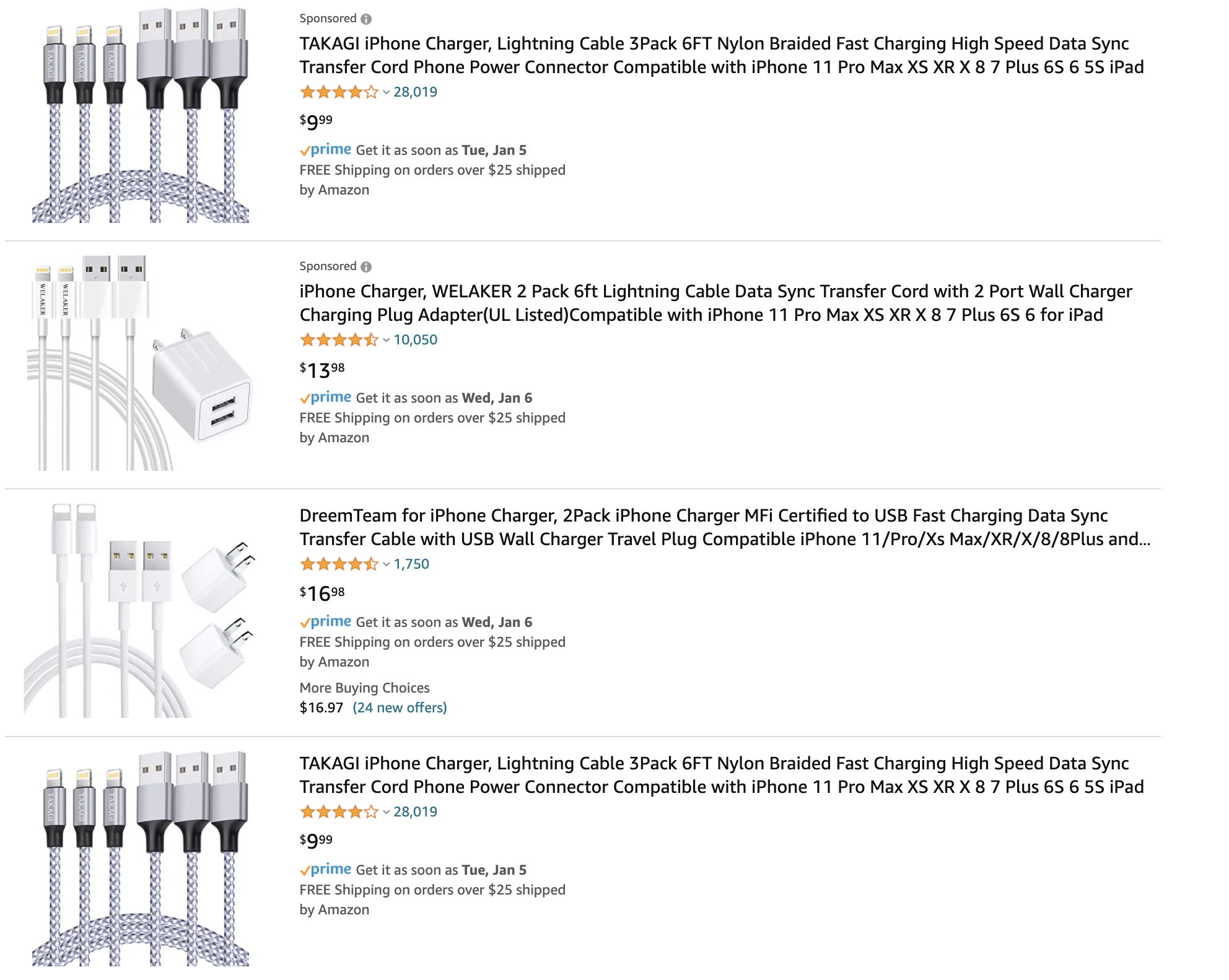
We can see here that the first two listings are clearly marked as being sponsored. Given that we're looking to discover the keywords helping products to rank organically, it makes sense to skip straight to these listings.
Take a look at the product titles to discover keywords being used by the listings showing first, adding to your list of keywords. Be sure to pay attention to frequently used keywords across different listings.
Other keyword variants that we clearly see here are iPhone models (XS, XR, etc.).
Just remember that the more (relevant) keyword variations that you're able to optimize for, the less chance you have of missing opportunities. At this stage, we're trying to build out a list that's as comprehensive as possible of keywords that describe the product.
Click into a listing and look at the 'about this item' and 'product description' blocks to find more keyword ideas.
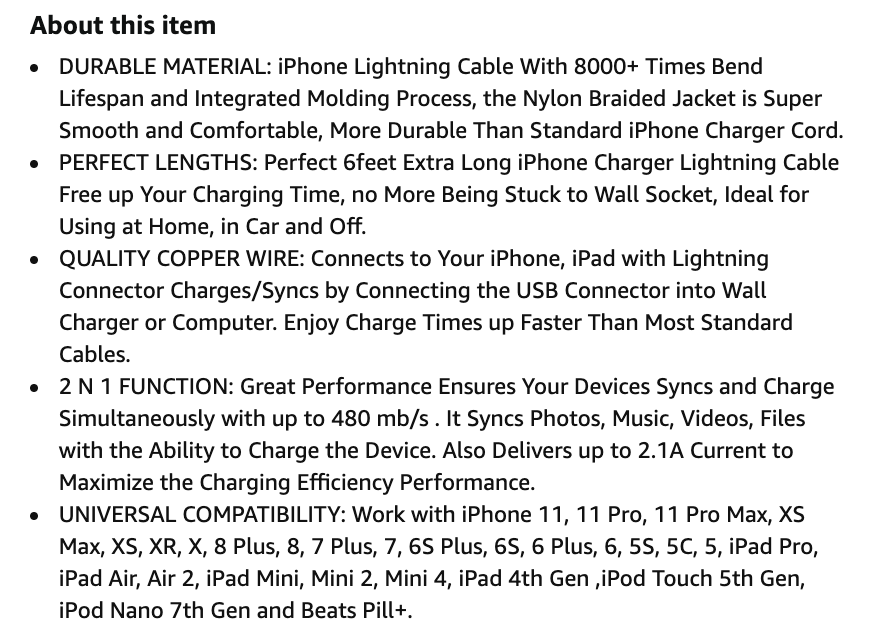

Analyze Top-Ranked Pages on Google
As we stated earlier, the goal is to find relevant keywords that you should be optimizing your products for on Amazon.
While Amazon's search bar and product listings can help you find the bulk of keywords that your potential customers are using, you can turn to Google and Semrush to help you find more.
Head to Google and run a search for your main keyword(s). In this case, we'll enter 'iPhone charger.'
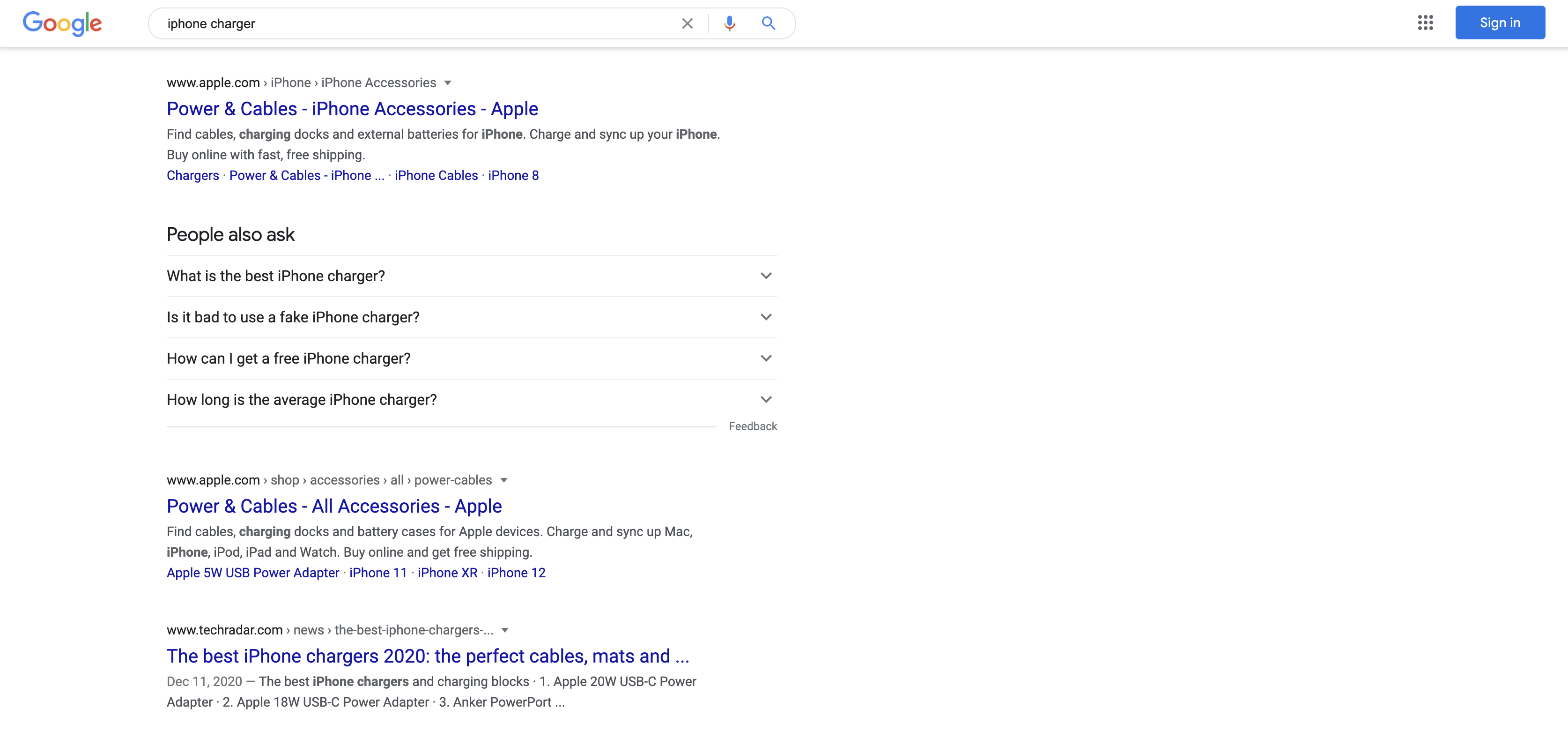
Take the top-ranked organic results, run these URLs through the Semrush Organic Research Tool, and head to the 'positions' tab.
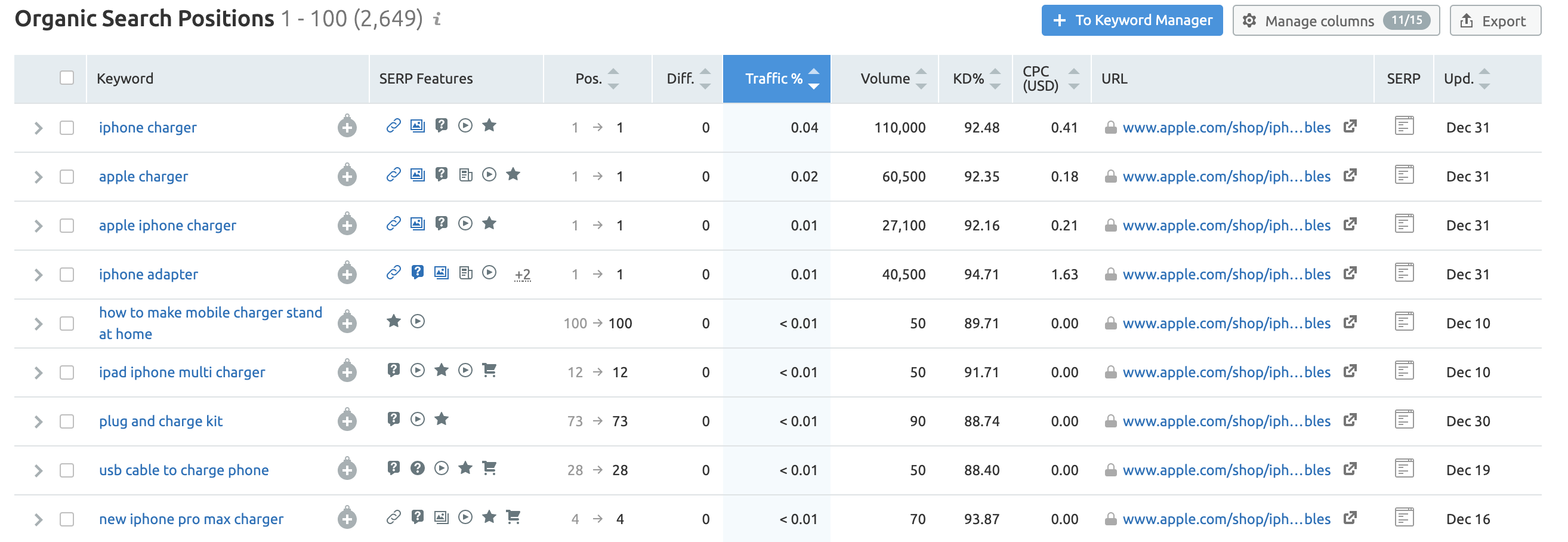
Just be sure to select 'exact URL' to make sure you're only returning keyword rankings for this page.

Here you'll find all of the keywords that the page ranks for on Google. Sort through relevant terms and use any that you hadn't already found for your Amazon listing.
Use the Semrush Keyword Magic Tool
Many user behaviors are the same across different search engines. Just because a consumer starts their search on Amazon rather than Google, it doesn't mean the searches they run are wildly different. At least not when it comes to product searches.
With this in mind, it makes sense to use the same tool(s) that you'd use when doing keyword research for your website to find the terms to optimize your Amazon listing.
The Semrush Keyword Magic Tool is perfect for Amazon keyword optimization. It can help you understand the priority of different keywords and figure out which are primary keywords and long-tail variations that you need to include in your descriptions but don't need to worry about including as prominently.
Head to the tool and enter a keyword, and hit 'search.'

You'll now see a list of relevant keywords that you can optimize your product listing around. While the search volumes relate to Google, not Amazon, these can help give at least some level of insight around the popularity of the search query.
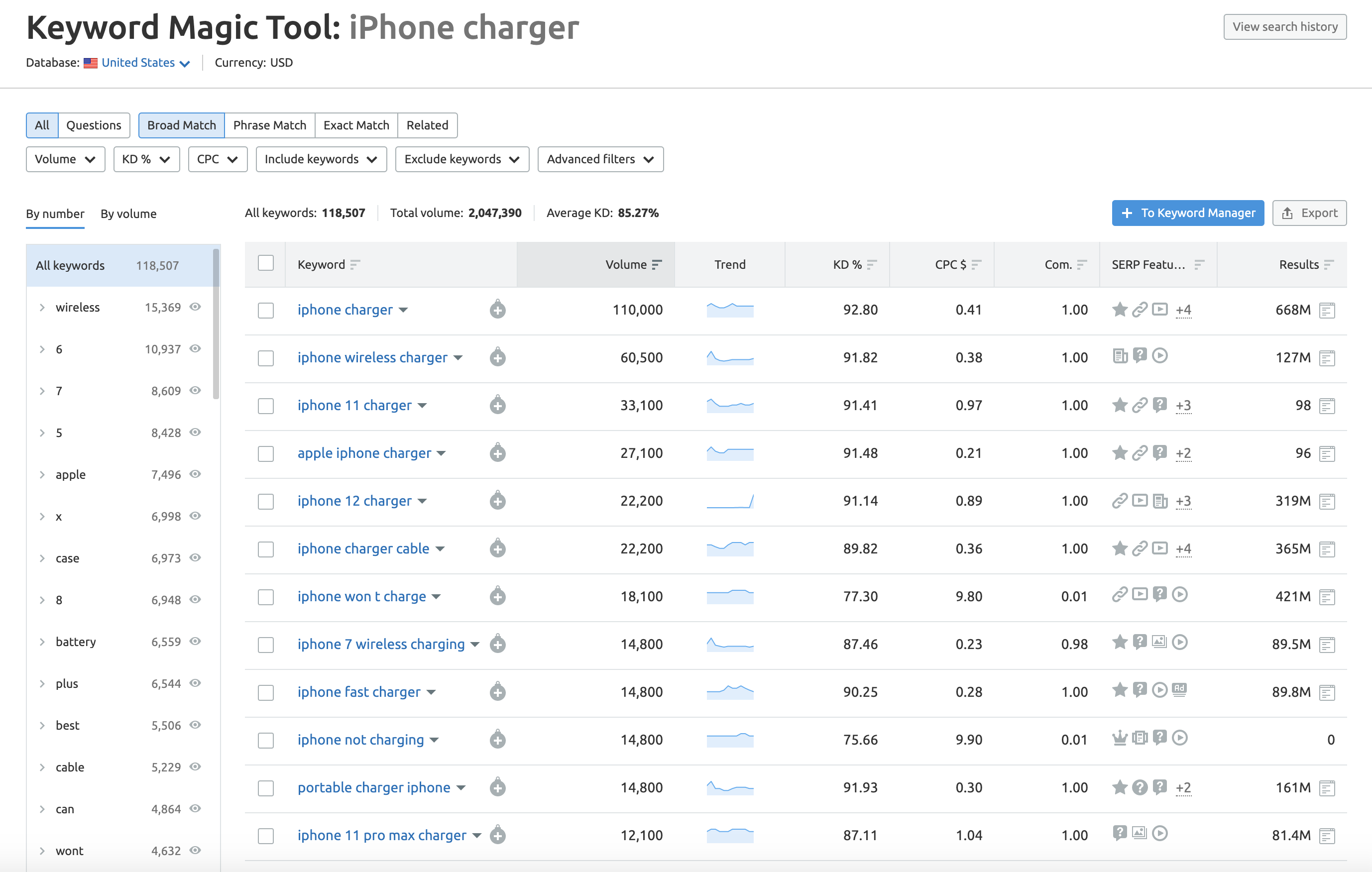
Semrush also has another toolkit, Sellzone, which is an Amazon marketing toolkit that allows sellers to monitor products, perform split testing, and much more. Take a look and see if it can help you!
Amazon is still an untapped opportunity for many ecommerce businesses, despite its continued growth over the last few years.
If you’re not yet using the channel to drive additional revenue, it’s an area that you should focus your efforts on sooner rather than later. If you aren’t selling on Amazon, but your competitors are, you’re openly giving them a competitive advantage and ignoring an untapped opportunity to drive revenue.
While no one is recommending that you focus all of your efforts here, a true multi-channel strategy is a smart one that will undoubtedly put you ahead of most of your competitors who are still trading primarily via their own website.
Adopt a mindset of being wherever your next potential customer is, and for most businesses selling online, that’s going to include Amazon.
But if you’re already selling on the platform, take the time to check in on your performance and visibility for key search terms and spend some time further optimizing your listings based on the keywords your customers are using.
There’s big money on Amazon, and every smart ecommerce marketer needs to be thinking one step ahead of the competition to make it work as another revenue-driving channel.Innovative SEO services
SEO is a patience game; no secret there. We`ll work with you to develop a Search strategy focused on producing increased traffic rankings in as early as 3-months.
A proven Allinclusive. SEO services for measuring, executing, and optimizing for Search Engine success. We say what we do and do what we say.
Our company as Semrush Agency Partner has designed a search engine optimization service that is both ethical and result-driven. We use the latest tools, strategies, and trends to help you move up in the search engines for the right keywords to get noticed by the right audience.
Today, you can schedule a Discovery call with us about your company needs.
Source:





